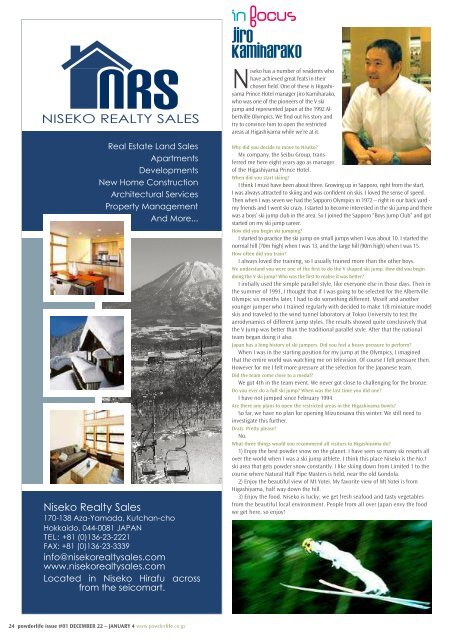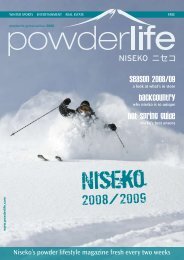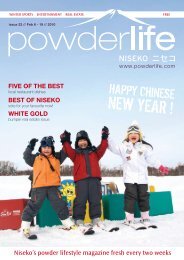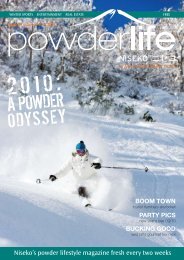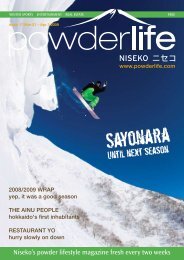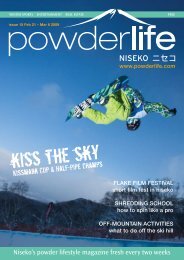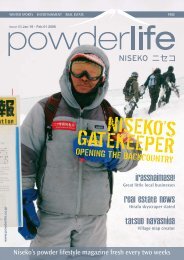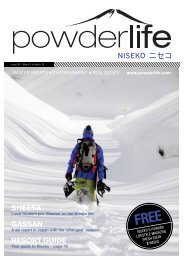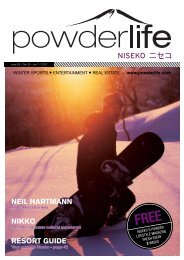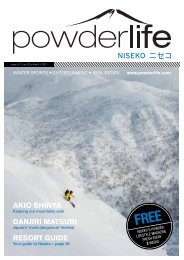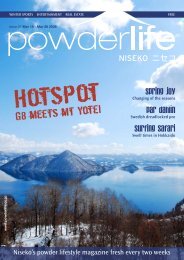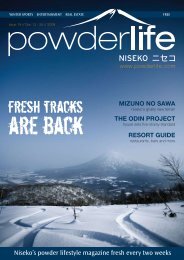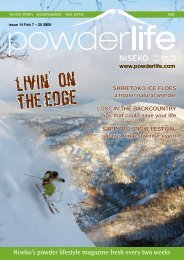Download (15.79 MB) - Powderlife
Download (15.79 MB) - Powderlife
Download (15.79 MB) - Powderlife
Create successful ePaper yourself
Turn your PDF publications into a flip-book with our unique Google optimized e-Paper software.
in focusJiroKamiharakoNiseko has a number of residents whohave achieved great feats in theirchosen field. One of these is HigashiyamaPrince Hotel manager Jiro Kamiharako,who was one of the pioneers of the V skijump and represented Japan at the 1992 AlbertvilleOlympics. We find out his story andtry to convince him to open the restrictedareas at Higashiyama while we’re at it.Why did you decide to move to Niseko?My company, the Seibu Group, transferredme here eight years ago as managerof the Higashiyama Prince Hotel.When did you start skiing?I think I must have been about three. Growing up in Sapporo, right from the start,I was always attracted to skiing and was confident on skis. I loved the sense of speed.Then when I was seven we had the Sapporo Olympics in 1972 – right in our back yard -my friends and I went ski crazy. I started to become interested in the ski jump and therewas a boys’ ski jump club in the area. So I joined the Sapporo “Boys Jump Club” and gotstarted on my ski jump career.How did you begin ski jumping?I started to practice the ski jump on small jumps when I was about 10. I started thenormal hill (70m high) when I was 13, and the large hill (90m high) when I was 15.How often did you train?I always loved the training, so I usually trained more than the other boys.We understand you were one of the first to do the V shaped ski jump. How did you begindoing the V ski jump? Who was the first to realise it was better?I initially used the simple parallel style, like everyone else in those days. Then inthe summer of 1991, I thought that if I was going to be selected for the AlbertvilleOlympic six months later, I had to do something different. Myself and anotheryounger jumper who I trained regularly with decided to make 1/8 miniature modelskis and traveled to the wind tunnel laboratory at Tokyo University to test theaerodynamics of different jump styles. The results showed quite conclusively thatthe V Jump was better than the traditional parallel style. After that the nationalteam began doing it also.Japan has a long history of ski jumpers. Did you feel a heavy pressure to perform?When I was in the starting position for my jump at the Olympics, I imaginedthat the entire world was watching me on television. Of course I felt pressure then.However for me I felt more pressure at the selection for the Japanese team.Did the team come close to a medal?We got 4th in the team event. We never got close to challenging for the bronze.Do you ever do a full ski jump? When was the last time you did one?I have not jumped since February 1994.Are there any plans to open the restricted areas in the Higashiyama bowls?So far, we have no plan for opening Mizunosawa this winter. We still need toinvestigate this further.Drats. Pretty please?No.What three things would you recommend all visitors to Higashiyama do?1) Enjoy the best powder snow on the planet. I have seen so many ski resorts allover the world when I was a ski jump athlete. I think this place Niseko is the No.1ski area that gets powder snow constantly. I like skiing down from Limited 1 to thecourse where Natural Half Pipe Masters is held, near the old Gondola.2) Enjoy the beautiful view of Mt Yotei. My favorite view of Mt Yotei is fromHigashiyama, half way down the hill.3) Enjoy the food. Niseko is lucky; we get fresh seafood and tasty vegetablesfrom the beautiful local environment. People from all over Japan envy the foodwe get here, so enjoy!shiretoko peninsulathe end of the earthby greg lundHokkaido is one of the world’s great undiscovered touristtreasures. As global warming increasingly impacts onpopular tourist destinations around the globe, Hokkaidois just starting to come into its own. The powder snowthat blankets the ski resorts in winter is one legacy of itslocation off the coast of Siberia, but in addition, it is justfar enough north of the equator to escape the humiditywhich makes mainland Japan quite hot in summer. Inshort, it is the ideal all-year round holiday destination. Asmore foreign ski visitors come to feel comfortable withNiseko, they might think about spreading their wings andtaking in the best of the rest of this magic island –‘The Garden of The Gods’.Higuma bears enjoy freshwater salmon at Shiretokofour seasons hokkaidoSo highly regarded is Shiretoko as a unique wildernessarea that in 2006 it was formally designated aWorld Heritage site - only the third one in Japan tobe so recognised by UNESCO.Shiretoko in the language of the native Ainu inhabitantsof Hokkaido means ‘the end of the earth’. And onceexperienced, it is easy to imagine how it got its name.If you take a map of Hokkaido and draw a line fromNiseko, close to the west coast, diagonally across theisland to the north-east coast, your attention is drawn toa long, thin, sliver of land that juts - dagger-like - out intothe North Pacific.Less than 100 kilometres long, and unpopulatedfor most of its length, it is one of the most remote, andspectacularly rugged places in Japan. A high mountainousspine rears sharply up from a very narrow coastal plaincharacterised by weathered basalt cliffs over which numerousrivers and hot spring waterfalls tumble down into almostimpossibly clear, aqua ocean. About half of the peninsula isnational park.It is home to very few people, but to a wonderfulvariety of exotic flora and fauna. The star inhabitantsare an estimated 300 or more Brown Bears. Growingto a weight of 400 kilograms and related to the NorthAmerican Grizzly, these wonderful creatures can be seenat close quarters in their natural habitat for most of theyear except winter.In Autumn, when the salmon run up the streams tospawn, the bears delight visitors with their fish-catchingskills as they seek to stack on protein and fat in preparationfor hibernation over the long, cold winter.Thousands of Ezoshika - a deer native to Hokkaido,roam the peninsula and are the source of excellentvenison dishes in the hunting season (outside the nationalpark). The peninsula is also the last safe habitat of oneof the world’s most spectacular owls, a very large speciesknown locally as Shima-fukuro, but elsewhere as Blackiston’sFish Owls. Growing to a height of up to 70 cm andwith a wing span nearing two metres, these extraordinarynocturnal creatures are being nursed back from the brinkof extinction in the national park, and can now sometimesbe seen at a small number of Japanese inns wherefood is left out at night to attract them into camera range.Sitting neck deep in an open air hot spring bath (rotemburo)under the stars with a cold beer on a still nightlistening to the call of the shima-fukuro is an experiencenot easily forgotten.Like Niseko though, Shiretoko saves its spectacular bestfor winter, when floating pack ice emanating from theSiberian coast is driven by the north west monsoon tojam up against the coastline of the peninsula, forming ashelf of solid, undulating, creaking and groaning ice thatstretches to the horizon.With the drifting pack ice (ryuhyo in Japanese) come seals,which in turn attract enormous eagles - magnificent brownbirds with white heads and bright yellow beaks - that followthem over from Kamchatka on the Russian coast. They floatoverhead like hang gliders or perch on higher outcrops of icewaiting for a seal to make a fatal mistake.Guides take adventurous groups out onto the ice totrek around headlands to frozen waterfalls, or to dive underthe ice sheet in warm dry-suits amid teeming sea life,and ice breaker cruise ships leave out of the port towns ofUtoro and Abashiri.Accommodation is limited, but mostly comfortable andvery friendly, and the seafood is to die for.And all this is only hours from Niseko by car or by train. Agreat place to start your exploration of the rest of Hokkaido.Greg Lund is a former diplomat who has lived and worked inJapan for much of the past 30 years, the last five in Hokkaido.24 powderlife issue #01 DECE<strong>MB</strong>ER 22 – JANUARY 4 www.powderlife.co.jpA Shiretoko waterfall cascades into the sea.


